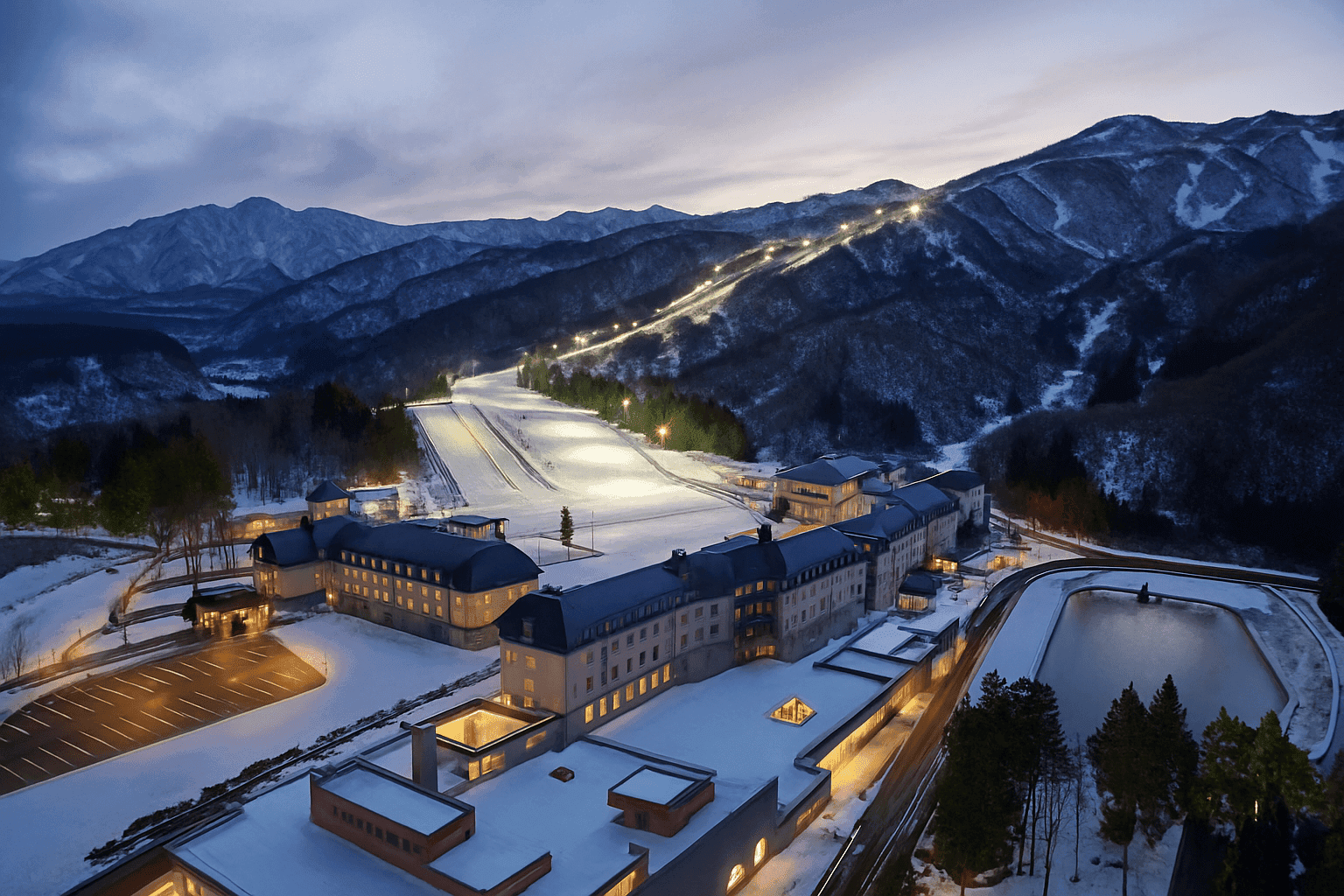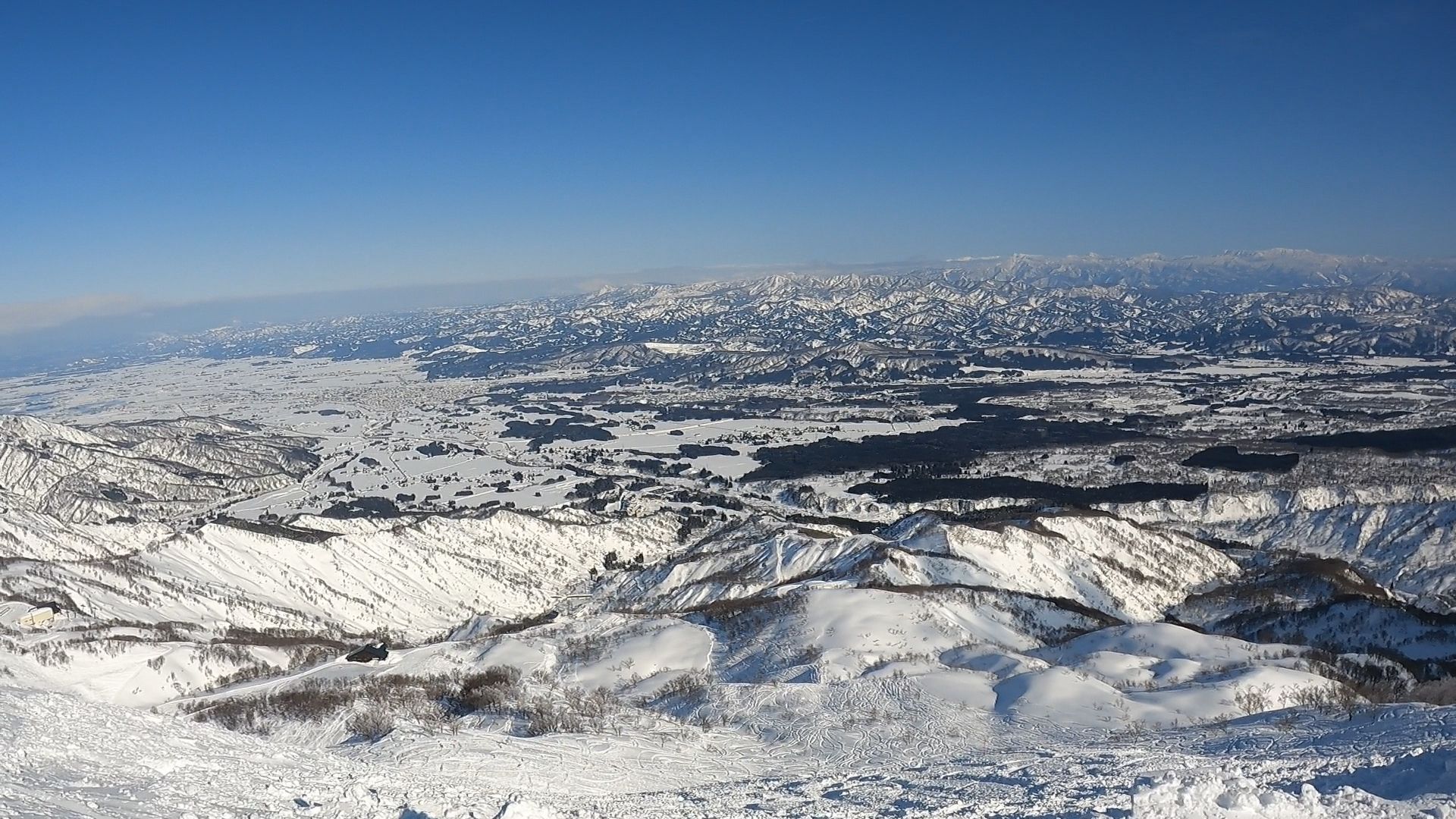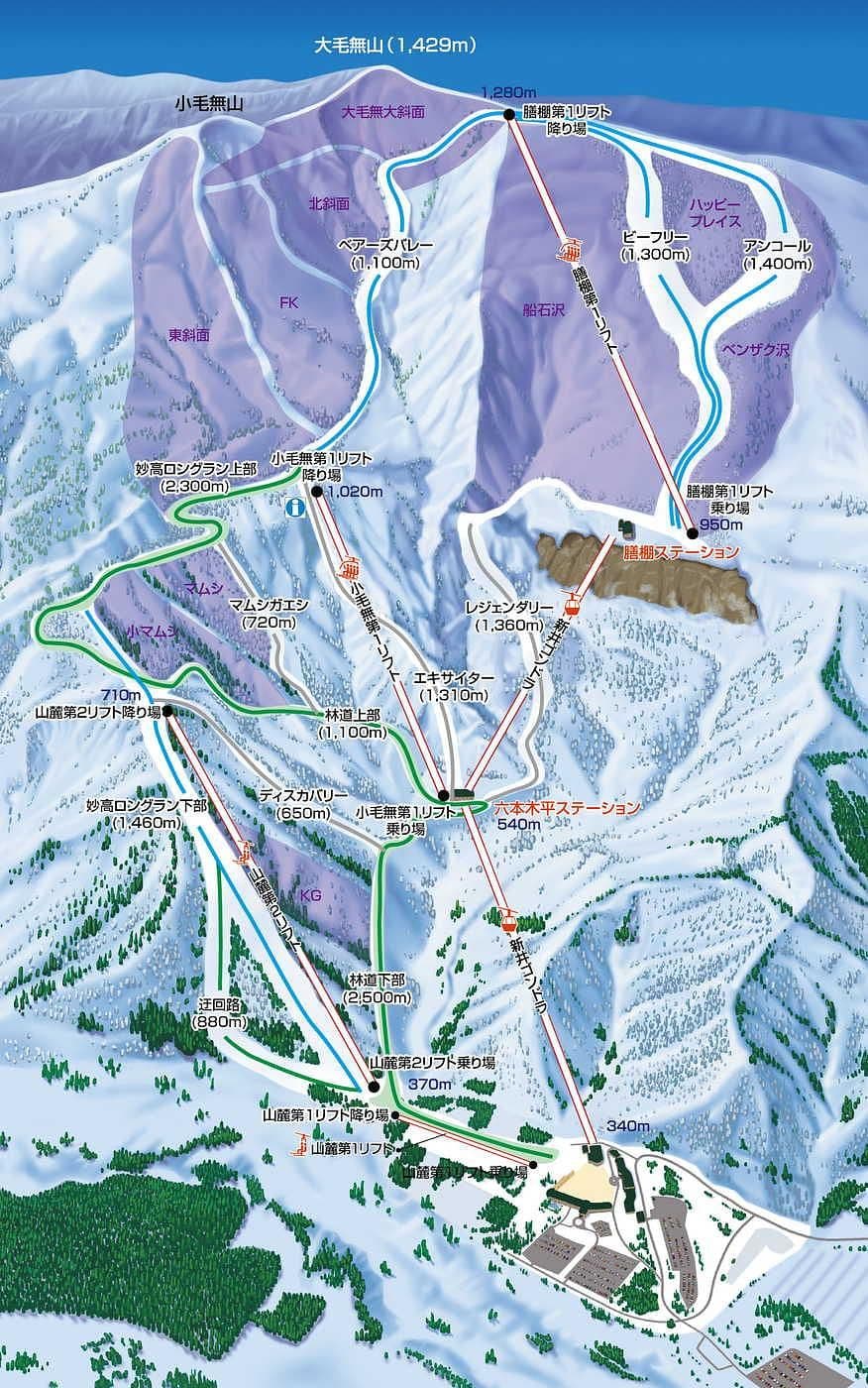Lotte Arai
Powder luxury — Niigata style

アライ
Big bowls, big grin
On paper, Arai looks simple: one gondola, a handful of chairs, and a tidy network of 14 named courses. On snow, it rides far bigger. The upper mountain drapes off Mt. Okenashi into amphitheater-like bowls, gullies, and light tree bands that fill in fast when the Sea of Japan does its thing. The draw here isn’t lapping endless groomers — it’s hunting clean lines in controlled freeride zones that ski like sidecountry without the faff.
The property is a true destination resort. Reopened in 2017 after a luxe refit, the base is a mini-village with onsen, pool, and a long list of restaurants and bars. It’s polished without feeling sterile, and English support is better than most Japanese mountains — signage is clear and lessons in English are easy to book. Families settle in, pow fiends post up by the patrol board, and everyone converges on the gondola when it’s been puking overnight.

Arai is famous for its freeride management. Patrol opens gates progressively as control work wraps, so storm mornings have a ritual: watch the board, nail the timing, and score those fresh tracks when the ropes drop. Above the trees you’ll find broad alpine bowls; lower down, light timber and gullies keep snow chalky days after a storm. This system means the quality snow lasts — especially midweek when the vibe is uncrowded and relaxed. Weekends can feel popular, but the terrain soaks up traffic well.
Was it once a hidden gem? Definitely. Before the relaunch it flew under most radars; these days, it’s firmly on the map. Prices reflect the premium experience — lodging and on-mountain dining skew upscale, and day tickets are at the higher end for Honshu — but if you want a plush base with high-quality snow and serious in-bounds terrain, Arai delivers. If you’re chasing a rustic village scene and ramen-shop nightlife, base yourself in Myoko or Joetsu and day-trip in when the storm track turns on.
Resort Stats
- Vertical951m (1280m → 329m)
- Snowfall~15m
- Terrain 25% 40% 35%
- Tree Riding
- Lift Pass$48
- Lifts1 gondola, 2 HS quads, 2 doubles
- Crowds
- Out of Boundscontrolled freeride zones
- Night Skiing
- Family Friendly
- Trails14
- Skiable Area~212ha
- Vibe
Trail Map

Powder & Terrain
Arai’s snow engine is classic Niigata. Cold northwest flow rips off the Sea of Japan, hits the first wall of mountains, and wrings itself out. Storms are frequent from late December through February, with that crisp, squeaky snow underfoot up high and a denser, grippier feel nearer the base. The hill rides bigger than its map suggests because the best lines lie between the marked pistes — in the bowls, gullies, and glades that fill in quickly and reset with each squall. On storm mornings, the play is to start at Village Station, ride the gondola to Zendana Station, and keep an eye on the operations board. Patrol tends to work from lower to higher elevation, unlocking zones as hazard drops through the morning.
The lift layout is simple and efficient, which matters when timing counts. The Arai Gondola is your trunk line, whisking you from the base to Zendana Station. From there, the Zendana high-speed quad takes you to the 1,280 m high point and serves the headline bowls. Kokenashi and the Sanroku 1st/2nd chairs handle mid-mountain and storm-day laps. Even on busy Saturdays, the network spreads people well, and because freeride zones open in stages, the crowd naturally disperses. If the weather socks in, you can still rack up quality turns — those mid-mountain chairs are clutch when the summit is on wind hold.
The freeride program is what makes Arai sing. Eight gated zones occupy the spaces between pistes — names like Zendana Bowl, Big Bowl, Mamushi, Mamushigaeshi, Happy Place, Be Free, Encore, and Bear Valley. These areas are within the resort boundary, avalanche controlled, and clearly roped and signed; you enter only through gates. Expect short traverses or rolling runouts back to lifts, but nothing too taxing. Etiquette matters here: line up at the rope, give patrol space to finish their work, and when it drops, move with purpose. There’s no friends on a powder day, but there’s also no reason to be that person elbowing at a gate.
Line evolution is predictable if you’ve got an eye for aspect and traffic. On a bluebird after a dump, upper bowls like Zendana and Big Bowl get shredded first. Once the obvious fall-line is peppered with tracks, slide toward the fringes where small ribs and suckers hold cold chalk. Mamushi and Mamushigaeshi have a habit of skiing better than they look from above thanks to wind-loaded pockets and sheltered gullies that keep sifted snow light and creamy. On low-viz days, duck into Wase or the KG zone for trees that keep definition and hold surface quality. When the legs need a breather, roll the long Myoko Long Run to reset and plan the next hit.
Crowd factor depends heavily on timing. Midweek is mellow — you can cycle freeride zones and keep finding clean panels through late morning, sometimes into early afternoon if the wind has done you a favor. Weekends and holidays pull a bigger crew, and the first sunny day after a storm is a magnet, but the progressive opening routine and a lack of choke-point lifts keep it civil. Night skiing focuses on lower-mountain pistes and is more about family time and extra mileage than powder hunting. If you’re staying on-site, it’s a great way to keep the legs moving before an onsen and an early night.
Who's it for?
Advanced and upper-intermediate skiers and riders who love controlled in-bounds freeride terrain will be in their element. If your idea of a perfect day is watching the gate board, timing patrol drops, and threading clean arcs through light trees and bowl walls, this is your spot. Confident intermediates will enjoy the long blues and consistent grooming. True beginners are fine near Sanroku, but progression is faster if you’re comfortable on steeper green/blue rollers. Park-focused riders will find a small setup, yet the main event here is natural terrain.
Accommodation
If you want ski-in/ski-out convenience with a plush finish, stay on-site. The connected hotel wings anchor a self-contained base with roomy public spaces, kid-friendly areas, gear storage that actually works, and an indoor-outdoor onsen that becomes a ritual after big days. Rooms run from efficient twins to generous suites, most with mountain or valley views. The vibe is international but calm — a place where you pad down to breakfast in slippers, check the gate board over espresso, and be on the gondola minutes later.
Value hunters can base near Joetsu-Myoko Station and day-trip. Business hotels deliver spotless rooms, simple breakfasts, and late check-ins for those rolling in on the last Shinkansen. The resort shuttle makes this painless if you align your arrival with the timetable; taxis bridge any gaps. Staying in town also opens up more dinner options and lets you tap convenience stores for snacks and supplies, which helps if you’re traveling with a crew and watching spend.
Crave a classic ski-town feel? Look to Myoko’s Akakura area about an hour away. You’ll trade door-to-door ease for narrow streets, local izakaya, indie lodges, and a wider après-dining circuit. It’s a smart combo — sleep in Akakura, surf the weather, and pounce on Arai when the gate board promises a late-morning reset. For longer stays, mixing nights between on-site comfort and Myoko character keeps the trip fresh.
Food & Après
On-site dining covers most bases without leaving the property. Breakfast buffets set you up for rope-drop mornings, café windows serve fast coffees and pastries, and there are sit-down options ranging from Japanese set menus to hearty Western plates. The steakhouse is a crowd-pleaser for celebratory dinners, while the hotel’s quieter bars and lounges are perfect for a nightcap and a scan of tomorrow’s forecast. Portion sizes are solid by Japanese resort standards, and there’s no shortage of kid-friendly choices.
For variety, a town night in Joetsu or Myoko is worth the detour. You’ll find ramen counters, yakitori joints, and cozy izakaya where your gear steams under the table and the staff happily guides you through local sake. Back at the resort, après is intentionally mellow — think onsen, good meal, early night, repeat. If you want thumping music and late finishes, plan those nights off-site and come back ready to move at first bell.
Getting There
From Tokyo, the Hokuriku Shinkansen gets you to Joetsu-Myoko in under two hours. From the station, resort guests can hop the scheduled shuttle — book ahead, especially on weekends. If you miss it, taxis are reliable and the ride is short. Driving from Tokyo is three to four hours in good conditions; carry chains and check the road reports because Niigata highways glaze over quickly when squalls roll through. Parking at the resort is straightforward, but it fills on holiday mornings, so arrive early if you’re day-tripping.
Getting around the region is easy if you want to sample nearby hills. Paid inter-resort shuttles and local buses link Arai with Myoko’s Akakura area and, with a little planning, to Madarao/Tangram and Nozawa. If you’re a crew of four with gear, a rental car can be cost-effective — just budget time for snow clearing and know that back roads are narrow. Luggage forwarding services are common in this region and make train travel blissful if you’re hauling fat sticks.
Japow Travel Tips
- Lift hours: Economy tickets load from 8:30; First Class gets early access at 8:00 during peak. Night skiing is typically lower mountain only.
- Freeride rules: The freeride zones are inside the boundary but strictly gated. Enter only through gates, heed closures, and expect staged openings after storms.
- Gear & safety: Beacon, shovel, and probe aren’t mandatory for the managed zones but are always smart; the terrain is consequential and weather shifts fast.
- Wind & weather: The top can close for wind. When it does, work the mid-mountain chairs — sheltered trees keep definition and the snow stays friendly.
- Crowd patterns: Midweek is relaxed. The first sunny day after a storm is busiest; time your laps for gate drops and you’ll still score.
- Language: English signage and instruction are better than average for Japan. Staff are used to international guests.
- Budget tips: Staying in Joetsu-Myoko or Myoko and day-tripping trims costs. Convenience stores near the station are clutch for snacks and quick breakfasts.
- Nearby resorts: Akakura (Myoko), Suginohara, Seki Onsen, Madarao/Tangram, and Nozawa Onsen are realistic add-ons to an Arai-based trip.
Verdict: Controlled chaos — in the best way
Arai is where premium resort polish meets powder-first operations. The freeride program is thoughtful, the terrain is proper, and the snow delivers far more often than not. If you’re planning a Japow mission and want guaranteed comfort with a high chance of snorkel mornings, pencil Arai in bold — then sharpen your timing and live by the gate board.